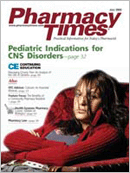Publication
Article
Pharmacy Times
Antibiotics, Probiotics, and Microflora
Author(s):
Approximately 300 million prescriptionsfor antibiotics arefilled in the United States everyyear.1 Although antibiotics play acrucial role in the health care system,their widespread use is increasinglycausing some serious healthconsequences. This article willexplain the benefits of the beneficialor "good"bacteria that populate thegastrointestinal (GI) tract, and themultiple problems that can developwhen the intestinal microflora isupset. It also will cover a simple yetcritically important patient counselingopportunity for pharmacistswith regard to antibiotics.
The human intestinal microfloracontains >100 trillion living bacteria,comprising from 100 to 400bacterial species.2 These organismsregulate important functions in thebody, such as the digestion andabsorption of nutrients, and aspectsof the immune system.
A healthy human GI tract contains~85% to 90% good bacteria.Everyone's GI tract harbors some"bad"bacteria and yeast organisms,but when they are present in smallnumbers (10%-15% of the GI population)they do not cause problems.When the balance between thegood and bad bacteria is upset,however, dysbiosis can develop.Dysbiosis refers to the symptomsand problems resulting from anunbalanced or dysfunctional intestinalmicroflora.
The primary cause of dysbiosis isthe use of antibiotics, which kill>99% of the good bacteria.3 Otherfactors that can cause or contributeto the development of dysbiosisinclude stress, birth control pills,and junk foods.
With dysbiosis, toxin-producingintestinal bacteria can cause a widevariety of symptoms. Digestivecomplaints are most common,including gas, bloating, intestinalpain and inflammation, and constipationand/or diarrhea. Unfortunately,the cause of these symptomsis frequently misunderstood andmisdiagnosed.
The 2 most important species ofbeneficial bacteria are Lactobacillusacidophilus, which primarily colonizesthe small intestine, and Bifidobacteriumbifidum, which inhabitsthe large intestine. Lactobacillusbacteria produce lactic acid, whichcreates a slightly acidic pH in theupper GI tract. This environment isfavorable for the beneficial bacteria,but it inhibits the growth of acidsensitivepathogenic bacteria.4 Thelactobacilli have another importantimmune system-enhancing feature,which is their ability to produce avariety of natural antibiotics in theintestines, such as lactocidin, lactobicillin,lactobreven, and acidolin.5L acidophilus bacteria also producethe enzyme lactase, which aids inthe digestion of lactose, or milksugar. Many lactose-intolerant peoplebenefit by taking acidophiluswith a meal containing milk ordairy products.
In the large intestine, bifidobacteriaproduce short-chain fatty acids(SCFAs), including acetic, propionic,butyric, lactic, and formicacids. The most plentiful SCFA producedby bifidobacteria is aceticacid, which exerts a wide range ofantimicrobial activity against yeasts,molds, and bacteria.6 Healthy intestinalmicroflora actively produceorganic acids and natural antibiotics,which are an important partof the immune system. Other studiessuggest that the beneficial bacteriaprovide protection against cancer.Various strains of beneficialbacteria reportedly aid in the detoxificationand elimination of carcinogens,modulation of procarcinogenicenzymes, and suppression oftumor growth rates.7,8
A study has revealed that beneficialbacteria in the GI tract also playan important role in whole-bodyimmunity. Researchers initiallymeasured the phagocytic index in 2groups of participants. The phagocyticindex is a measure of how effectivelyneutrophils and macrophages(types of white blood cells)attack and destroy bacteria, viruses,and other foreign invaders throughoutthe body. The pretest phagocyticindex was 38.9% in group 1 and46.3% in group 2. After supplementingwith bificobacteria for 3weeks, the phagocytic index ingroup 1 increased to 86.5%. Aftersupplementing with L acidophilusfor 3 weeks, the phagocytic index ingroup 2 increased to 84.4%. Theseresults represent a dramatic increasein the strength of the immune systemin these participants.9
The quality and potency of probioticproducts varies greatly. Afterfinishing the course of antibiotics,counsel your patients to take a probiotictwice daily for 2 weeks. Eachdose should contain at least 1 to 2billion live bacteria.
Dr. Pelton is director ofeducation at IntegrativeHealth Resources Inc.
For a list of references, send a stamped,self-addressed envelope to:References Department, Attn. A. Stahl,Pharmacy Times, 241 Forsgate Drive,Jamesburg, NJ 08831; or send an e-mailrequest to: [email protected].

Newsletter
Stay informed on drug updates, treatment guidelines, and pharmacy practice trends—subscribe to Pharmacy Times for weekly clinical insights.






